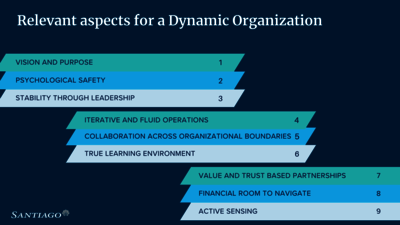Building a resilient organization in a volatile world
The question of how organizations can remain viable in a “VUCA” world has long preoccupied entrepreneurs and CEOs. Few know today that the first usage of VUCA dates back to the late 1980s1,2, which makes the term older than most LinkedIn users, and thus presumably older than the readers of this article as well3. The term became trending in the 1990s, the world became volatile, uncertain, complex, and ambiguous. However, this initially referenced the collapse of the USSR, after which the one clear enemy was suddenly missing. VUCA evolved and outgrown its infancy. Now the term is increasingly found in business and keeps on polarizing. Google Trends for example shows a significant uptake in search queries related to VUCA since 2015. Those who participate in the discussions vigorously debate whether everything is becoming even faster, more uncertain, more complex, and more ambiguous as well as whether we need a new term for this phenomenon or not and finally if this change is good or bad for us.
While these discussions are all interesting and should be held, the core issue addressed here is what companies can do to operate successfully in the given environment. What can companies do to operate in an environment that sees one global crisis after the other? What can companies do to embrace rather than protect against technology trends? And what are the demands towards leadership in the future?
The first two decades of this century have made it clear that the world we live in is complex and massively interdependent. Whether it's some virus or innovation, nowadays both have quick global implications, often impossible to foresee. In most cases we can only understand the dimensions these disruptions will reach once the damage is done. So, we must act under uncertainty; there is no other world. Nonetheless, a significant number of market players are still trying to address new problems with outdated approaches. This is quite understandable because these approaches – be it strategy and strategy processes, structures, leadership behavior, general processes, or beliefs – have brought these players to where they stand today. However, the world has evolved; therefore, market players must also evolve. Otherwise, success becomes a matter of pure luck.
This is not a criticism of past entrepreneurial efforts; it is pure evolution. Today no one would compete in a car race with a Mercedes-Benz Silver Arrow, would they? Likewise, the top football clubs do not play with libero anymore. Those who continue to evolve and adapt will endure. We call this quest to evolve: The Dynamic Organization. So, what do Dynamic Organizations look like?
To start, there is no "one-size-fits-all" solution. However, there are nine specific factors that can serve as cornerstones for developing these unique solutions, as they have a significant influence on business survivability. It also means that the categorization should be considered as tendential rather than definitive. However, it serves as a basic structure for addressing the topics.
1. Vision and Purpose
A clear direction, in the form of vision and purpose, should be ensured. Companies with a clear vision and purpose can respond more effectively to changes and stay aligned with their long-term goals—following the motto "think long-term, act short-term." In the end, you won't arrive at exactly the point you pictured in your vision; however, this is precisely what helps you stay on course.
2. Psychological Safety
Establishing an appropriate organizational culture is vital. This topic has gained increasing attention in recent years, and this trend will continue as more and more companies recognize the immense contributions it makes to productivity. These are due to the positive impact of a suitable organizational culture on agility, innovation, adaptability, and the learning capacity of organizations as well as individuals4. A positive organizational culture supports employee engagement, promotes collaboration, and fosters readiness for change. And it all starts with a clear vision and purpose.
3. Stability through Leadership
Attention should also be given to leadership behavior. An empowering leadership style, in particular, has shown to inspire and motivate teams. Leaders provide clear direction, foster a supportive environment, and empower employees to make their own decisions. This also promotes innovation and improves decision quality and speed if implemented correctly. Interactions with interdisciplinary collaboration and organizational culture should be emphasized here.
4. Iterative and fluid operations
Organizations should focus on continuous improvement. A mindset of continuous improvement helps organizations identify vulnerabilities, address them, and make progress based on that. This includes a regular and conscious examination of organizational practices and enhances them. This is clearly dependent on the culture of the organization and the behavior of the leaders.
5. Collaboration across organizational boundaries
In addition, interdisciplinary collaboration plays an important role as well. Promoting collaboration across departments and areas fosters a holistic approach to problem-solving and decision-making. This interdisciplinary collaboration helps organizations tackle complex challenges and adapt more effectively to uncertainties or changes.
6. True learning environment
Closely related to the previous points, organizations need to address knowledge sharing. By fostering a culture of knowledge sharing and learning they can leverage the collective intelligence and experiences of employees. Sharing best practices, insights, and lessons learned improves an organization's ability to respond and adapt to new situations.
7. Value and trust based partnerships
Turning the focus more outward, the relevance of market relationships must be emphasized. Strong relationships with customers, suppliers, and other stakeholders are essential for business resilience. By understanding market dynamics and maintaining positive relationships, adaptability to change can be optimized, and viability can be extended.
8. Financial room to navigate
As a prerequisite for the implementation of many of the above points, securing necessary resources is crucial. Resilient organizations have secured the necessary financial, technological, and human resources to withstand disruptive events. Strategic allocation of existing resources is crucial to maintain the required dynamics. This factor also fuels the relevance of organizational culture, as the shortage of skilled workers can only intensify in the coming years and organizations will increasingly compete for the best minds. Here, the culture of the respective company is one of several important factors.
9. Active sensing
Finally, the last point on the list is proactive change. Anticipated and welcomed changes are easier to embrace than those that come as a surprise. By actively observing the environment, trends, and even proactively initiating trends, one can stay ahead of the wave and mitigate potential risks.
While this article provides an overview of the key factors and a certain framework it will be followed by contributions from Santiago experts in each of the mentioned nine areas in the coming weeks. These articles will provide practical insights into best practices as well as advantages and disadvantages to help you find your own path to a Dynamic Organization
Get in touch with Santiago to learn more about our expertise and references in this area.
1 www.vuca-world.org/where-does-the-term-vuca-come-from/, accessed on the 07th of July 2023.
2 www.techtarget.com/whatis/definition/VUCA-volatility-uncertainty-complexity-and-ambiguity, accessed on the 10th of July 2023.
3 DataReportal; Hootsuite; We Are Social – Statista 2020; jens.marketing/linkedin-statistiken/, accessed on the 8th of July 2023.
4 E.g., Amy C. Edmondson, Leading in tough times, 2022; www.exed.hbs.edu/blog/post/leading-tough-times-amy-edmondson, accessed on the 15th of July August 2023, Henrik Bresman & Amy C. Edmondson, Research: To Excel, Diverse Teams Need Psychological Safety, 2022 hbr.org/2022/03/research-to-excel-diverse-teams-need-psychological-safety, accessed on the 15th of July August 2023, etc.



